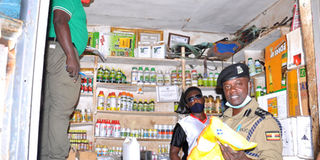Counterfeit inputs on downtrend as agriculture ministry intensifies crackdown

SSP John Ssewanyana with MAAIF inspector during their operation on counterfeit inputs in Bunyangabu District recently. Photo by Eve Muganga
What you need to know:
In Uganda, the prevalence of counterfeiting is highest within herbicides. Counterfeiting in maize seeds, especially hybrid varieties is also prevalent, but less in herbicides.
By Eve Muganga
The inspectors from the Crop protection and certification department of Ministry of Agriculture Animal Industry and Fisheries (MAAIF), have confirmed that counterfeit inputs on market have gone down as they intensified the crackdown.
According to the agriculture police commandant, SSP John Ssewanyana, there’s a downtrend of counterfeit products on the market.
“We have been conducting enforcement on counterfeit products across the country. In 2018, about 20,000 litres of counterfeit inputs were impounded, 2,000 litres were impounded in 2019 and 8,000 litres /kg were impounded during our enforcement on Wednesday this week in greater Masaka and Western regions,” he said.
SSP Ssewanyana said the fake products were mainly expired seeds, seeds with forged labels, adulterated chemicals and seeds mixed with food colour among others. They were picked across the districts of Masaka, Kalungu, Kyotera, Mpigi, Kamwenge, Bunyangabu, Kyenjojo and Kyegegwa, worth Shs10m.
“The operation was to assess the level of compliance by the traders and sensitise farmers on where to get genuine seeds from,” he added.
Mr Ssewanyana said that the enforcement will continue in other parts of the country to ensure farmers access quality inputs during this rainy season.
In Uganda, the prevalence of counterfeiting is highest within herbicides. Counterfeiting in maize seeds, especially hybrid varieties is also prevalent, but less in herbicides.
“Smallholder farmers rarely use fertilisers and therefore counterfeiting is not as prevalent as in the other two value chains but, it remains a recognised issue,” he said.
Mr Isaac Wamatsembe, an inspector from ministry of agriculture, warns of the most common types or signs of counterfeiting.
Mislabelling: This is where the label does not reflect contents in the package. This is often with imports. Consumer ignorance, as it is still difficult for smallholder farmers to determine if a product has been adulterated (diluted or fake) or if it is a sub-standard product (expired or poor quality) based on the label alone.
Labels and packages are tampered with, and the product itself may look and smells like the authentic product.




